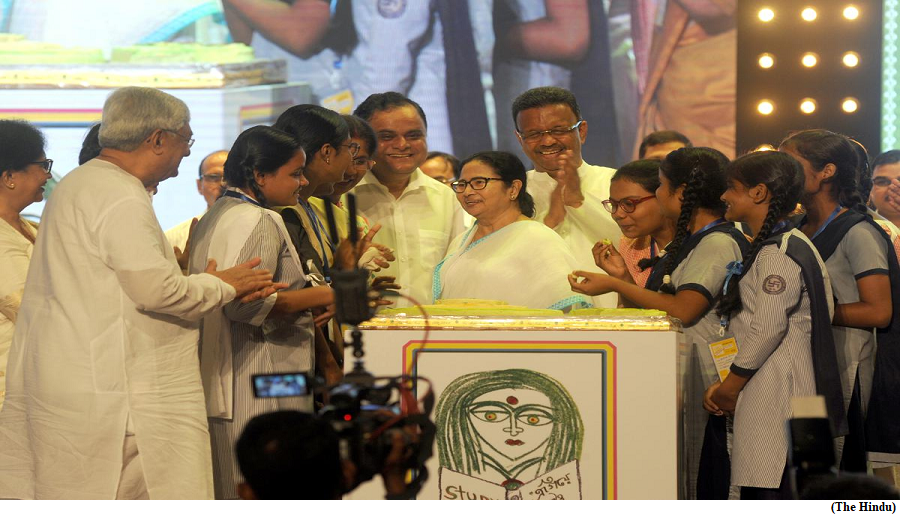Rise in child marriages in West Bengal (GS Paper 1, Social Issues)

Why in news?
- A recent study on child marriage in India noted the overall decrease in child marriage across the country but pointed out that four States, mainly Bihar (16.7%), West Bengal (15.2%), Uttar Pradesh (12.5%), and Maharashtra (8.2%) accounted for more than half of the total headcount burden of child marriages in girls.
What are the key findings?
- The paper titled ‘Prevalence of girl and boy child marriage across States and Union Territories in India, 1993–2021: a repeated cross-sectional study’ highlights that one in five girls are still married below legal age in India.
- It states that while some States have achieved dramatic decreases in prevalence and headcount for child marriage in girls, “other states have struggled, such as West Bengal”.
Rise in West Bengal:
- Child marriage, particularly girl child marriage, has posed a challenge for policy-makers in West Bengal for decades.
- The National Family Health Survey-5 carried out in 2019-20, points out that the women aged 20-24 years who were married before the age of 18 years in West Bengal remains one of the highest in the country at 41.6%.
- The percentage was the same during the National Family Health Survey- 4. The all-India figure of women aged 20-24 years getting married before they turn 18 is pegged at 23.3%.
What has been the impact?
- While child marriage is considered a human rights violation and a recognised form of sexual and gender-based violence, the adverse impact of child marriage is manifested across maternal and child health in the State.
- Earlier, 10 infants died at Murshidabad Medical College and Hospital in a span of 24 hours. The hospital authorities said the majority of the children were born with extremely low birth weight.
- Because of child marriage and poverty, children are born with a low birth weight and sometimes doctors are not able to save them.
- Murshidabad, one of the economically poorer districts of the State, has one of the highest numbers of child marriages in West Bengal.
- The NFHS - 5 points out that 55.4% of women aged 20-24 years are married before the age of 18 years in the district. The district saw a rise from NFHS-4 numbers, which stood at 53.5 %.
What have been the policy interventions?
- The West Bengal government has made a number of policy interventions to stop child marriage.
- Launched in October 2013, Kanyashree Prakalpa is a conditional cash transfer scheme aimed at incentivising the schooling of all teenage girls between the ages of 13 and 18, and simultaneously discouraging child marriage.
- The scheme has completed 10 years and was recognised at an international level with a United Nations Public Service Award 2017. The West Bengal Budget for the year 2023-24 said the scheme has covered 81 lakh girls.
Girls in Higher Education:
- While the school enrolment of girls has increased in the State, questions are being posed based on NFHS data and the Lancet study of whether the scheme has achieved its promise of arresting child marriage.
- In 2023, the West Bengal Higher Secondary Examination, also referred to as the Class XII board exam, saw a 14.84% increase in female candidates. The number of girls appearing in the examination was 1.27 lakh higher than boys and totalled 57.43% of the total candidates.
- The All-India Survey of Higher Education for 2020-21 also puts the number of estimated enrolment of girls in West Bengal at 9.29 lakh, which is higher than the boys enrolment which stood at 8.63 lakh.
Correlation between literacy rate and child marriage:
- The girl’s enrolment in schools has significantly increased over the past few years and yet the incidence of child marriage remains high in West Bengal.
- Despite high literacy, the incidence of child marriage is also disproportionately high in some districts: for example, the Purba Medinipur district with over 88% literacy rate has the highest incidence of child marriage of more than 57.6% as per NFHS- 5.
- Experts also link child marriage with migration as a significant population of the State go out to work in other States.
- Along with Kanyashree, the State government also has cash incentive schemes for marriage of girls named ‘Rupashree Prakalpa’.
- Certain families avail cash benefits of both the schemes to organise marriage of girls, sometimes soon after cashing in on the school scheme.
Implementation of laws:
- In 2021, West Bengal registered 105 cases under Prohibition of Child Marriage Act (PCMA), 2006 whereas States with a smaller population and lesser instances of child marriage registered more cases, like Tamil Nadu, which registered 169 cases, Karnataka 273 and Assam 155 cases respectively.
- To curb child marriage, the Government had introduced the Prohibition of Child Marriage (Amendment) Bill, 2021 in Parliament in December 2021 for raising the age of marriage of women to 21 years to bring it on par with the men and the Bill has been referred to a Parliamentary Standing Committee.
What lies ahead?
- Experts point out that West Bengal has emerged as an example where cash incentives and existing laws have failed to check child marriages.
- In 2022, the West Bengal government called for a district action plan to curb child marriage and issued necessary guidelines.
- However, in the absence of a social campaign involving all stakeholders including panchayats, schools and local communities and without a political will to enforce the existing laws the situation at the grass roots will not improve as rapidly as it has in other parts of the country.


